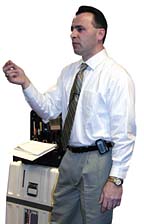
The owner of DiFilippo's Service Co., Paoli, Pa., has been around the trade since the age of 12, initially working for his brother's small family company. It was obvious DiFilippo was having fun (and in his element) talking about, handling, and passing around what he believed to be the necessary tools of the trade for those residential contractors who attended his educational session entitled "What's In Your Toolbox?" at the 2004 Air Conditioning Contractors of America (ACCA) convention in New Orleans.
Unlike Tim Allen or Tim Taylor, DiFilippo was dead serious.
"If you're going to send out your service tech to fix Mrs. Jones' furnace, and you expect him to do it quickly, and you expect him to do it right, and you expect to make money, and not take six hours, you are going to have to buy him the tools. End of discussion," asserted DiFilippo, not one to mince words.
"I know you guys are saying, ‘Man, you are talking about a lot of money.' And it is a lot of money. I spent a lot of money on tools. Tools alone are about five grand for each truck. But that comes back threefold."
Take it from a residential contractor who survives on providing service only - period. Not one single installation. With only four full-time service techs, the company's sales were over $700,000 last year - and, in DiFilippo's book, it starts with having the right tools.
"We need to perform outstanding service, do it productively, and do it right the first time," he told his audience. "If we don't, the client will not call us back. That is why I provide the tools and diagnostic testing equipment for my technicians. ... How do you expect your techs to be fast and correct without giving them the proper tools? It is not an expense but an investment."
With that, he turned to his black, well-kept Chicago Tool Case Co. toolbox and patted it ever so gently.
"When I come to your door, I'm carrying this," he said. "The doctor is here. It makes a great impression. I can fix anything with this toolbox."
It's A Long List
DiFilippo can thank his local television repairman for starting his fascination with tools when he came to the house to fix the family's TV set."I was about eight or nine," remembered DiFilippo. "When he came in with an attache case and he opened that sucker up to fix our television set, every tool had a spot. I was just in awe. So when I started to go in and doing installations, I started carrying a toolbox."
Maybe 30 years ago, all an HVAC mechanic needed was a two-gallon bucket, rags, combination volt and amp meter, a roll of duct tape, a few screwdrivers, a hammer, and a pocket thermometer.
Not so now.
Today's high-efficiency furnaces and air conditioners require the latest in diagnostic equipment and proper high-end tools, he said.
"Just walk into any major car dealership's service garage and look around," he said. "You will see massive tool chests almost as big as the cars they are repairing. Why? The mechanic knows that to do his job properly and quickly, he has to have the right tools."
From a 1/4-inch nut driver to a coil fin tool, DiFilippo pulled out tool after tool after tool from his toolbox, making sure that each attendee knew of its importance. He was not afraid of passing them around, either.
"By the way, I'm taking inventory," he noted. "Make sure no one walks out with anything. Please."
For instance, he noted that any technician working on the latest high-efficiency furnaces should have a Magnahelic gauge to measure the draw for pressure safety switch and draft motor operation; a digital multimeter that reads volts, amps, and Ohms; and a carbon monoxide analyzer with oxygen and flue temperature readout.
"If you don't," he warned, "then you cannot repair these furnaces quickly or accurately."
Over an hour time span, DiFilippo went through over 100 tools on his "go shopping" list. (For his entire "must have" list of tools, see the sidebar below.)
If you have any questions, I'm sure DiFilippo would be more than happy to talk to you about one of his favorite subjects.
Sidebar: What's In Your Toolbox?
Here is what Vince DiFilippo suggests every residential service technician should have in his/her toolbox:
And More!
Here are some other tools and diagnostic equipment, which DiFilippo suggests a residential service tech should have access to when on a call:
Mark Skaer is editor-in-chief. He can be reached at 248-244-6446, 248-362-0317 (fax), or markskaer@achrnews.com.
Publication date: 04/05/2004
Report Abusive Comment